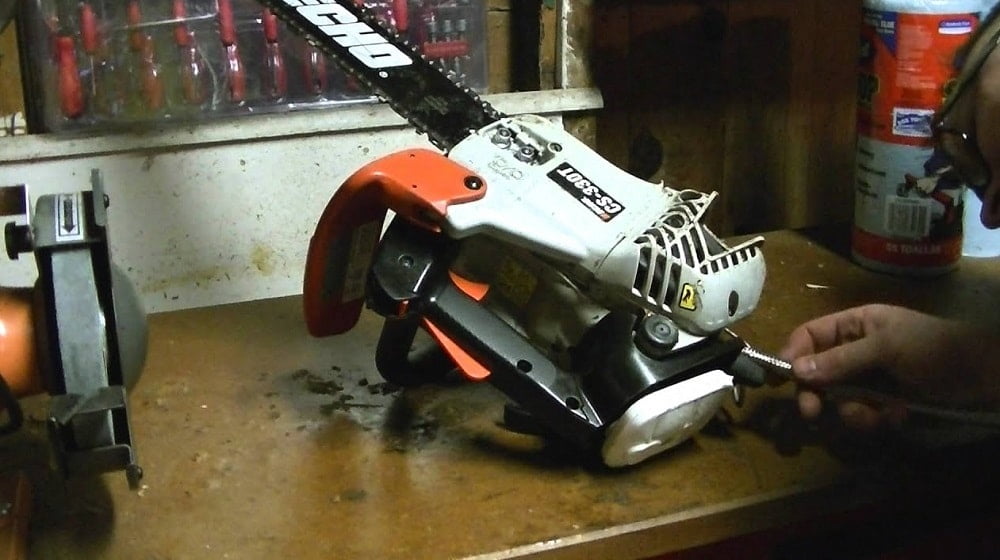A chainsaw should have a compression of between 90 and 120 psi (pounds per square inch). The exact amount of compression needed will depend on the type and size of the chainsaw, as well as its age. Generally speaking, newer models require more compression than older ones.
Additionally, larger engines need higher compression than smaller ones. If your engine does not seem to be performing at its best or if it is difficult to start, you may want to check the chain saw’s compression to see if it needs adjustment.
When it comes to chainsaws, compression is an important factor that needs to be considered. Generally speaking, the more compression a chainsaw has, the better it will perform and last longer over time. A good rule of thumb is that a chainsaw should have at least 50 pounds of compression per square inch (PSI) when it’s not running in order for it to operate properly and efficiently.
If your chainsaw doesn’t meet this standard, then you may need to replace or repair parts on your saw in order to ensure its longevity and top performance levels.

Credit: toolsadvisorpro.com
Will a Chainsaw Run on 90 Psi Compression?
The answer to this question is no, a chainsaw will not run on 90 psi compression. Chainsaws generally require higher levels of compression than what is found in most engines that operate at 90 psi. The minimum amount of pressure for a chainsaw engine is usually around 120-130 psi.
Additionally, the type and size of the cylinder can also affect how much pressure it needs in order to function properly. A smaller cylinder may only need 80-90 psi while a larger one could require up to 150 or even 180 psi depending on its design. It’s best to check with your manufacturer for specific requirements before operating any chainsaw so as not to damage the engine or reduce its efficiency and performance over time.
How Do I Know If My Chainsaw Has Good Compression?
You can test the compression of your chainsaw by removing the spark plug, and then connecting a compression gauge to it. Once connected, you should pull the starter rope and observe the pressure reading on the gauge. If it reads higher than 75-80 PSI (pounds per square inch), then your saw has good compression.
Additionally, if you hear a popping sound when starting up or while running your chainsaw, this could mean that there is an issue with its compression and you should get it checked out as soon as possible.
How Much Compression Should My Husqvarna Chainsaw Have?
When it comes to determining how much compression your Husqvarna chainsaw should have, there are a few factors to consider. Generally speaking, the ideal compression for a Husqvarna chainsaw is between 100 and 120 psi. However, this may vary depending on the type of saw you’re using and its age.
Additionally, if your saw has been running for some time without being serviced or having its spark plug replaced, then it’s likely that the compression will be lower than normal. To ensure that you get the most out of your Husqvarna chainsaw and keep it in good working order, make sure to check the manufacturer’s recommended specifications as well as have regular maintenance done by a qualified technician.
What is the Minimum Compression for a 2 Stroke?
The minimum compression required for a two-stroke engine depends on the size of the engine and its operating conditions. Generally speaking, most two-stroke engines require a minimum compression ratio of 6:1 or higher to operate efficiently, though some may need as high as 10:1 depending on their design. In order to ensure optimal performance, it is important that all components are in good working condition, such as spark plugs and piston rings being free from damage or wear.
Additionally, proper maintenance should be performed regularly and fuel/air mixture ratios must also be adjusted accordingly.
The customer bought a running Stihl Chainsaw w/ 130lbs compression. What to look for when buying used.
Chainsaw Low Compression Symptoms
Chainsaw’s low compression symptoms can include difficulty starting the motor, a noticeable decrease in power, and smoke coming from the exhaust. Low compression can be caused by several issues, including worn piston rings, a broken or bent connecting rod or crankshaft, and valve damage. If you think your chainsaw may have low compression due to one of these problems, it’s important to take it to an experienced mechanic for diagnosis and repair.
How Much Compression Should a Husqvarna Chainsaw Have
When it comes to determining the correct amount of compression for your Husqvarna chainsaw, it is important to consult your owner’s manual. This will provide you with specific details about the model and make of your saw as well as instructions on how much compression should be present in order for optimal performance. Generally speaking, a good rule of thumb is that an ideal reading should fall around 120 PSI or more; however, depending on the age and condition of your machine, this number could be higher or lower.
Chainsaw Compression Test
A chainsaw compression test is an important step in the maintenance of a chainsaw. This test measures the amount of pressure created when the piston compresses air and fuel during the engine’s ignition cycle. A low reading may indicate wear on internal parts, such as valves or rings, which can lead to poor performance or even engine failure if not addressed promptly.
Therefore it is recommended that this procedure be performed regularly for optimal operation and reliability of your chain saw.
Stihl Chainsaw Compression Chart
Stihl chainsaws are one of the most popular and reliable brands on the market. Understanding how to read their compression chart can help ensure that your saw is running at its optimal performance level. The Stihl chainsaw compression chart provides a range of values for engine pressure, or “compression”, that should be maintained in order to avoid engine damage.
This allows users to easily check if their chain saw’s power output is within an acceptable range before it needs maintenance or repair.
Conclusion
In conclusion, it is important to understand how much compression a chainsaw should have in order to keep the engine running properly and safely. The ideal amount of compression will vary depending on the make, model, and size of your chainsaw as well as its age. If you are unsure about how much compression your particular chainsaw needs, consult with a professional technician or refer to the manufacturer’s specifications for guidance.
Keeping an eye on your chainsaw’s compression levels and regularly checking them can help ensure that you get optimal performance from your machine over time.
Table of Contents

